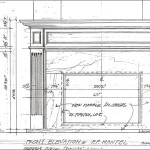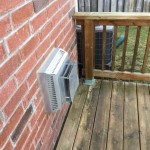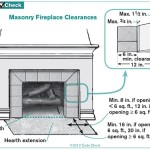Can You Paint A Red Brick Fireplace? A Comprehensive Guide
The question of whether one can paint a red brick fireplace is a common one among homeowners seeking to update the aesthetic of their living spaces. The answer is unequivocally yes, red brick fireplaces can be painted. However, the process is not as simple as applying a coat of paint. Careful preparation, selection of appropriate materials, and meticulous application are crucial for achieving a durable and visually appealing finish. This guide will provide a comprehensive overview of the considerations and steps involved in painting a red brick fireplace.
Brick, while often considered a charming and rustic material, can sometimes clash with the desired interior design scheme. The natural red hue may feel outdated or simply not align with a modern or minimalist aesthetic. Painting a brick fireplace offers a cost-effective alternative to more extensive renovations like brick removal or refacing. It allows homeowners to dramatically alter the look of their fireplace, creating a focal point that complements the overall style of the room.
Before embarking on this project, it is essential to understand the nature of brick and its inherent properties. Brick is a porous material, meaning it readily absorbs moisture. This porosity affects the type of paint that should be used and the necessary preparation steps to ensure proper adhesion and prevent future damage. The presence of soot, creosote, or other contaminants can further complicate the painting process, requiring thorough cleaning and potentially specialized cleaning agents.
A key consideration is the desired final appearance. Options range from a solid, opaque coat of paint to a more textured or distressed finish. The choice will influence the selection of paint type and application techniques. Furthermore, the fireplace's functionality should be considered. If the fireplace is frequently used for burning wood, heat-resistant paint is a necessity to prevent cracking, peeling, and discoloration.
Key Point 1: Preparation is Paramount
The success of any painting project hinges on thorough preparation, and painting a brick fireplace is no exception. Neglecting this crucial step can lead to a substandard finish that is prone to peeling, cracking, or staining. The preparation phase involves cleaning, repairing any damage, and priming the brick surface.
The first step is to thoroughly clean the brick. This process removes dirt, dust, soot, and any other contaminants that may be present. A stiff-bristled brush and a solution of trisodium phosphate (TSP) or a similar degreasing cleaner are typically used. It is important to wear protective gloves and eyewear when working with TSP, as it can be irritating to the skin and eyes. The cleaning solution should be applied to the brick surface and scrubbed vigorously to remove any loose debris and grime. After scrubbing, the brick should be rinsed thoroughly with clean water to remove any residue from the cleaning solution. Allow the brick to dry completely before proceeding to the next step.
Once the brick is clean and dry, inspect it for any cracks, chips, or other damage. These imperfections should be repaired before painting. Small cracks can be filled with a patching compound designed for masonry. Larger cracks or damaged bricks may require more extensive repairs, such as replacing the affected bricks. It is crucial to use materials that are compatible with brick and suitable for high-temperature environments if the fireplace is used for burning wood. Allow the patching compound to dry completely according to the manufacturer's instructions before moving on.
Priming is an essential step that ensures proper adhesion of the paint to the brick surface. A high-quality masonry primer is recommended. The primer seals the porous brick, preventing the paint from being absorbed excessively and ensuring a uniform finish. Apply the primer evenly, using a brush or roller designed for rough surfaces. Allow the primer to dry completely according to the manufacturer's instructions before applying the paint. Some primers may require multiple coats for optimal coverage.
Key Point 2: Selecting the Right Paint
Choosing the correct type of paint is crucial for achieving a durable and aesthetically pleasing finish on a brick fireplace. The ideal paint should be able to withstand temperature fluctuations, adhere well to porous surfaces, and resist staining from soot and other contaminants. Several types of paint are suitable for brick fireplaces, each with its own advantages and disadvantages.
Latex paint is a popular choice for interior brick surfaces due to its ease of application, durability, and availability in a wide range of colors and finishes. It is water-based, making it easy to clean up, and it emits low levels of volatile organic compounds (VOCs), contributing to better indoor air quality. When selecting latex paint for a brick fireplace, choose a high-quality acrylic latex paint designed for masonry surfaces. This type of paint is formulated to adhere well to porous materials and withstand moisture. For fireplaces that are frequently used, consider using a heat-resistant latex paint to prevent cracking and peeling.
Another option is masonry paint, which is specifically formulated for use on brick, concrete, and other masonry surfaces. Masonry paint is typically thicker than latex paint and provides excellent coverage and durability. It is also highly resistant to moisture and mildew, making it a good choice for fireplaces in damp or humid environments. However, masonry paint can be more difficult to apply than latex paint and may require special application techniques. It is also typically available in a more limited range of colors.
For fireplaces that are frequently used for burning wood, heat-resistant paint is a necessity. This type of paint is specifically formulated to withstand high temperatures without cracking, peeling, or discoloring. Heat-resistant paint is typically available in a limited range of colors, but it is essential for ensuring the longevity and safety of the painted fireplace. It is important to carefully follow the manufacturer's instructions when applying heat-resistant paint to ensure proper adhesion and performance.
Consider the desired finish when selecting the paint. Matte finishes tend to hide imperfections well and create a soft, non-reflective appearance. Satin finishes offer a slight sheen and are easier to clean than matte finishes. Semi-gloss and gloss finishes are the most durable and easiest to clean, but they can also highlight imperfections. A matte or satin finish is generally recommended for brick fireplaces to create a more natural and less overwhelming look.
Key Point 3: Application Techniques and Considerations
The application of paint to a brick fireplace requires careful attention to detail and the use of appropriate techniques. Proper application ensures a uniform finish, minimizes the risk of drips and runs, and maximizes the durability of the painted surface. Several factors should be considered during the application process, including the use of appropriate tools, the number of coats of paint, and the drying time between coats.
The choice of application tools can significantly impact the final result. A combination of brushes and rollers is typically used to paint a brick fireplace. A high-quality paintbrush with synthetic bristles is ideal for painting mortar joints and other hard-to-reach areas. A roller with a nap length appropriate for rough surfaces is recommended for painting the flat brick surfaces. A longer nap length will allow the roller to reach into the crevices and irregularities of the brick, ensuring even coverage.
Multiple thin coats of paint are preferable to a single thick coat. Applying multiple thin coats allows the paint to dry properly and adhere better to the brick surface. It also minimizes the risk of drips and runs. Allow each coat of paint to dry completely according to the manufacturer's instructions before applying the next coat. This typically takes several hours or even overnight, depending on the type of paint and the ambient temperature and humidity.
When painting the mortar joints, use a paintbrush to carefully apply the paint, ensuring that it fills the crevices and covers the entire surface. Avoid applying too much paint, as this can lead to drips and runs. Use a damp cloth to wipe away any excess paint from the brick surfaces adjacent to the mortar joints. When painting the flat brick surfaces, use a roller to apply the paint in a uniform layer. Overlap each pass of the roller slightly to avoid leaving any gaps or streaks.
During the application process, it is important to maintain adequate ventilation in the room. Open windows and doors to allow fresh air to circulate. Wear a respirator mask to protect yourself from inhaling paint fumes. It is also advisable to cover the surrounding area with drop cloths to protect against paint splatters. Protect any adjacent surfaces that are not being painted with painter's tape. Remove the tape carefully after the paint has dried.
After the final coat of paint has dried completely, inspect the fireplace for any imperfections. Touch up any areas that require additional coverage. If necessary, apply a clear sealant to protect the painted surface from stains and moisture. Allow the sealant to dry completely before using the fireplace.
Maintaining a painted brick fireplace involves regular cleaning and occasional touch-ups. Clean the fireplace regularly with a soft cloth and a mild detergent solution. Avoid using harsh chemicals or abrasive cleaners, as these can damage the painted surface. If any cracks or chips appear in the paint, touch them up promptly with fresh paint. By following these maintenance tips, you can ensure that your painted brick fireplace remains beautiful and functional for many years to come.

How To Paint A Brick Fireplace
How To Paint A Red Brick Fireplace Look Like Stone

How To Update A Brick Fireplace With Chalk Paint Diy Beautify Creating Beauty At Home

Diy Fireplace Overhaul Part 2 Homemade Food Junkie

Painting Brick Fireplace White A Renovation Story

Fireplace Decorating My Brick Painted Is Stunning Paint Makeover Remodel

Modern Rustic Update To Fireplace Paint And Wall Behr
How To Update A Brick Fireplace With Chalk Paint Diy Beautify Creating Beauty At Home

Mortar Wash Brick Fireplace Makeover Dimples And Tangles

How To Paint A Brick Fireplace The Right Way








